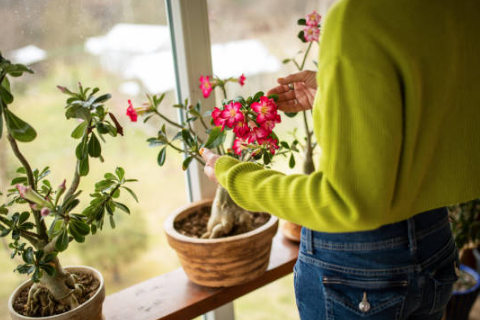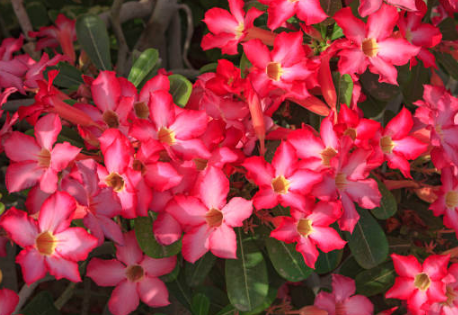The desert rose (Adenium obesum) is a slow-growing plant, typically putting on only about 12 inches of growth per year. It’s prized as a bonsai specimen for its thick, succulent trunk, slender green leaves, and vibrant, trumpet-shaped flowers in deep pink. Native to Africa, the Middle East, and Madagascar, this plant can be grown indoors or outdoors depending on your location. In warm tropical zones (USDA zones 11 and 12), it thrives outside year-round, but in colder areas, it’s best grown indoors. Plant it in spring, as it will die if exposed to frost or freezing temperatures. Keep in mind that desert rose belongs to the dogbane family and its sap is toxic to both humans and pets.
Desert Rose Care
This plant needs careful watering and plenty of sunlight. It prefers consistently warm temperatures and well-draining, sandy soil.
Light
Desert rose thrives in bright sunlight. Indoors, place it on a sunny south-facing windowsill or in a sunroom where it receives direct light all day. Outdoors, plant it in a location without tall plants blocking the sun, but consider giving it some protection from harsh midday rays to prevent leaf burn.

Soil
As the name suggests, desert rose is adapted to dry, desert-like conditions. It needs well-draining sandy or gritty cactus mix soil. The ideal pH is slightly acidic to neutral, around 6.0.
Water
During the growing season (late spring through summer), keep the soil moist but not soggy. Always let the soil dry out completely before watering again. Be sure to use a pot with good drainage holes. If the soil stays too wet, the roots may rot. In fall and winter, the plant usually enters dormancy. At that point, reduce watering drastically—once a month is usually enough. If the trunk looks full and firm (relative to plant size), that’s a sign it has adequate water.
Temperature and Humidity
Keep your plant warm. Prolonged exposure to temperatures below 50°F (10°C) can be fatal. Desert rose prefers temperatures between 65°F and 90°F (18°C–32°C) and does not tolerate frost. Humidity isn’t a concern, as it’s adapted to hot, dry environments.
Fertilizer
During the active growing season, feed once a month with a balanced, water-soluble fertilizer diluted to half strength. Do not fertilize during the dormant period.
Pruning
Sanitize your pruning shears with rubbing alcohol or a diluted bleach solution before and after use. Remove any frost-damaged branches as soon as new growth begins. Trim back leggy stems to maintain a symmetrical shape. Cut away branches that cross or rub against each other, making cuts just above a leaf node or at the junction of two stems.
Propagation
Desert rose can be propagated via stem cuttings. Here’s how:
-
Gather gardening gloves, disinfected pruners, rooting hormone, clean pots, and well-draining potting mix.
-
Wear gloves to avoid skin contact with the toxic sap. Cut a 5–6 inch (13–15 cm) stem from the tip of a healthy branch.
-
Let the cut end dry for a day or two.
-
Moisten the cut and dip it in rooting hormone.
-
Plant the cutting in well-draining medium, like perlite or a sand and potting soil mix.
-
Water daily, but make sure the soil drains well.
-
In two to six weeks, the cutting should start rooting. You’ll notice new growth, or the stem will resist when gently tugged.

Repotting
Repot when roots outgrow the pot or become compacted—usually once every one or two years. If you want to limit the plant’s size, keep it in the same pot. The best time to repot is in late winter or early spring, just as new growth appears. Wait until the soil is completely dry, then gently remove the plant from its pot. Knock off old soil and trim away any dead or rotting roots. If you notice cuts or bruises, treat them with a fungicide or antibacterial solution. Replant in fresh soil, spreading out the roots. Let the plant sit dry for about a week before watering to minimize transplant shock. After that, water thoroughly but make sure the soil drains completely. Never leave it sitting in water.
Overwintering
Desert rose cannot tolerate frost or extended cold. When temperatures drop to 50°F (10°C), it will drop its leaves and enter dormancy. Move the plant indoors and stop watering. Store it in a frost-free place like a garage or basement that stays above freezing. It won’t need light or much attention until spring. When warmer weather returns, gradually resume watering and place it near a sunny window before eventually moving it outside again.
Getting Desert Rose to Bloom
Desert roses come in a variety of flower colors thanks to extensive hybridization.
It typically takes about 7–8 months after sowing for a desert rose to bloom, depending on growing conditions. Most plants bloom in summer.
The flowers are bright pink, rose, or red trumpet-shaped blossoms, and the leaves are vibrant green. During the winter dormant period, the plant loses both its leaves and flowers.
To encourage more blooms, make sure your plant gets at least six hours of light daily and is fertilized monthly during spring and summer. If your plant was recently repotted, it may focus its energy on root development rather than flowering—give it time to adjust to its new environment.

